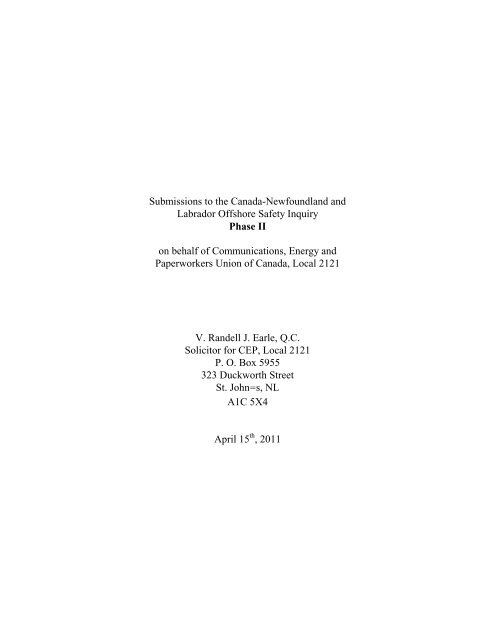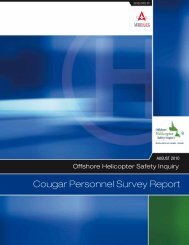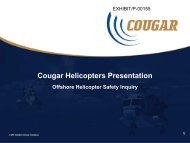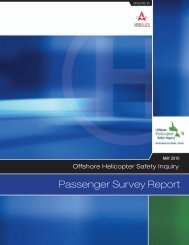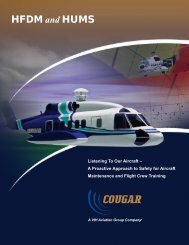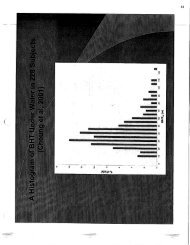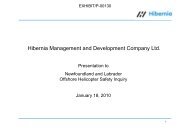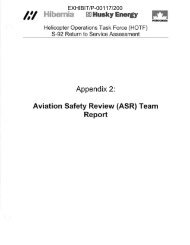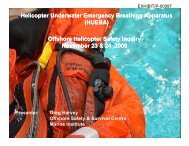Submission Phase II CEP, Local 2121 April 2011 - Offshore ...
Submission Phase II CEP, Local 2121 April 2011 - Offshore ...
Submission Phase II CEP, Local 2121 April 2011 - Offshore ...
Create successful ePaper yourself
Turn your PDF publications into a flip-book with our unique Google optimized e-Paper software.
<strong>Submission</strong>s to the Canada-Newfoundland andLabrador <strong>Offshore</strong> Safety Inquiry<strong>Phase</strong> <strong>II</strong>on behalf of Communications, Energy andPaperworkers Union of Canada, <strong>Local</strong> <strong>2121</strong>V. Randell J. Earle, Q.C.Solicitor for <strong>CEP</strong>, <strong>Local</strong> <strong>2121</strong>P. O. Box 5955323 Duckworth StreetSt. John=s, NLA1C 5X4<strong>April</strong> 15 th , <strong>2011</strong>
IntroductionThe mandate of the Commission, as amended on October 7 th , 2010, provides in respect of<strong>Phase</strong> <strong>II</strong>:AUpon completion of the Transportation Safety Board of Canada investigationinto Cougar Helicopter Sikorsky S-92A crash, the Commissioner shall undertakea review of the sections of the Report therefrom that deal with matters which arespecifically within the mandate of the CNLOPB and particularly the findings inrespect thereof and shall advise the CNLOPB:(a)(b)which findings should result in actions being recommended to beundertaken by CNLOPB and how they should be implemented;which findings should result in actions being recommended to beundertaken by other legislative or regulatory agencies.The Commissioner may retain and, as needed, request the services of independentspecialists whose function would be to provide information on or interpretinformation and issues relative to the Inquiry. Independent specialists retained bythe Commissioner may be requested by the Commissioner to appear before theCommissioner as experts.@This mandate is subject to the limitation contained in Section 6 of the Terms of Referencewhich state, in part, as follows:AThe Commissioner=s mandate does not include an examination of any issuesrelated to the airworthiness of aircraft, training of flight crew, or flight proceduresor any other matters which are included in the Transportation Safety Board ofCanada investigation into Cougar Helicopter Sikorsky S-92A crash except to theextent specifically described in Paragraph 5 hereof.@Paragraph 5, on the other hand, provides:ASpecifically, the Commissioner shall inquire into, report on and makerecommendations in respect of:(d)safety plan requirements for operators in ensuring that their safetyplans, as represented to and approved by the Board, are maintainedby helicopter operators.@<strong>CEP</strong>, <strong>Local</strong> <strong>2121</strong> understands that the CNLOPB has the authority, in respect ofoperators= safety plans, to require the operators to impose contractual obligations, on
3helicopter operators providing services to the operators, which are in excess of therequirements of Transport Canada. An example of this sort of obligation imposed byCNLOPB on the offshore operators is the current requirement that passengers be trainedto use and be issued the HUEBA. <strong>CEP</strong>, <strong>Local</strong> <strong>2121</strong> takes the limitation imposed inSection 6 of the Terms of Reference to mean, for instance, that it would be inappropriatefor the Commissioner to inquire into the standards flight training for helicopter pilots orthe content of simulator training, but it would not be inappropriate for the Commissionerto consider whether helicopter pilots ought to have extra knowledge where thatknowledge is relevant to the safety of the passengers who are workers being transportedto offshore installations in the Newfoundland and Labrador <strong>Offshore</strong>.Simply put, <strong>CEP</strong>, <strong>Local</strong> <strong>2121</strong> feels it is appropriate for this Commission to makerecommendations to the Regulator whereby the Regulator will be advised to alter thecontent of the contractual relationship between helicopter operators and offshoreinstallation operators so as to make the helicopter transportation of workers in theNewfoundland and Labrador <strong>Offshore</strong> safer than that which would arise from compliancewith the minimum standards set by Transport Canada.Information DisclosureIn its <strong>Phase</strong> I Report, the Inquiry recommended as follows:AIt is recommended that information about airworthiness directives and incidentreports should be promptly communicated to the workers/passengers by noticesposted on the website of the helicopter operator(s), so that those who want theinformation may have access to it. Alert Service Bulletins are not included inthis recommendation because they are usually maintenance related. The actualprotocol, including the details of the information to be posted, should bedeveloped by the Regulator, in conjunction with the oil operators, the helicopteroperator(s), and worker representatives.@The Transportation Safety Board Report indicates that on October 8 th , 2008, SikorskyHelicopters issued Safety Advisory (SA)SSA-S92-08-007 to advise operators ofupcoming changes to the AAM, which included an interim enhanced inspectionprocedure for the removal and installation of the main gearbox filter bowl assembly.These procedures included an enhanced visual examination of the studs, checking run offand run on torques, and mandatory replacement of used nuts with new nuts. OnNovember 5 th , 2008, with AMM Revision 13, these enhanced inspection proceduresbecame mandatory industry wide. On January 28 th , 2009, Sikorsky issued Alert ServiceBulletin (ASB)92-63-014 requiring the replacement of the main gearbox filter bowl
4titanium mounting studs with steel studs, within 1,250 flight hours or one year.Inspections had been mandatory since the release of AMM Revision 13 and both Sikorskyand the FAA felt the immediate risk of reoccurrence (stud failure) had been adequatelymitigated and would allow safe operation during the specified compliance period.Reference: Transportation Safety Board Report, Section 1.18.3.7During the period between the release of Revision 13 of the Aircraft Maintenance Manualand March 23 rd , 2009, none of the S-92A operators reported to Sikorsky that they hadfound any damaged studs while performing the enhanced inspection nor had theycontacted Sikorsky to comment on the steps involved with the enhanced procedures. OnMarch 23 rd , 2009, the FFA issued Emergency AD2009-07-53 for Sikorsky S-92helicopters which required, before flight, removing all titanium studs that attach the maingearbox filter bowl assembly to the main gearbox and replacing them with steel studs.Sikorsky did not receive any reports of damaged studs between issuance of AMMRevision 13 in November, 2008 and when AD2009-07-53 was issued in March, 2009.However, it did receive 59 studs from various operators after they had complied with theAD. Sikorsky examined these studs and found that they had varying degrees of gallingof the threads, indicating multiple nut removals. Some of the thread damage was visiblewithout the use of magnification. Considering the timing of AMM Revision 13 onNovember 5 th , 2008 and the issuing of AD2009-07-53 on the 23 rd of March, 2009 and theaverage S-92A utilization times, the studs received by Sikorsky would have come fromhelicopters that had their filter bowls removed at least three times.Reference: Transportation Safety Board Report, Section 1.18.3.10In its findings as to causes and contributing factors, the Transportation Safety Boardfound:ACougar Helicopters did not effectively implement the mandatory maintenanceprocedures in Aircraft Maintenance Manual (AMM) Revision 13 and, therefore,damaged studs on the filter bowl assembly were not detected or replaced.@Reference: Transportation Safety Board Report, Section 3.15The Transportation Safety Board found that there appeared to be a general consensusamongst the S-92A community that the issue respecting maintenance of the main gearboxfilter bowl assembly was not urgent.Reference: Transportation Safety Board Report, Paragraph 1.18.3.9
5It is quite clear that the issue was in fact entirely urgent. The maintenance procedure wasdetermined by the manufacturer and, with the sanction of the Federal AviationAdministration, to be mandatory. The premise of Recommendation 7, <strong>Phase</strong> I for theexclusion of Alert Service Bulletins was that they were maintenance related. It issubmitted that the findings of the Transportation Safety Board suggest that this is not asound basis for exclusion of these items from an obligation to post information on thewebsite.The posting of these items on the website performs two functions. Firstly, it satisfiesthe right of passengers to know that matters crucial to their safety are extant. Secondly,the posting of the matter for public disclosure elevates the importance of the issue in themind of the helicopter operator and its employees. Good management and human naturerespond to the principle that it is easier to do something required than to explain why ithas not been done. Elevation of the disclosure obligation to include air safety advisoriesand Alert Service Bulletins will reinforce that behaviour.It is submitted that the Commissioner ought to recommend that Recommendation 7 in<strong>Phase</strong> I be amended so as to require immediate posting on the helicopter operator=swebsite of all safety advisories and Alert Service Bulletins.Operational Restrictions on FlightsRecommendation 9 arising from <strong>Phase</strong> I of the Inquiry recommended as follows:AIt is recommended that operation requirements, in addition to those of TransportCanada, specifically those relating to items such as operational sea states andvisibility, be set by the Regulators as goal oriented objectives to which the oiloperators will respond. Approaches to meeting selected goals should be widelydiscussed by the Regulator, oil operators, helicopter operator(s), workerrepresentatives, stake holders and experts engaged by any of the parties.@The Transportation Safety Board Report recommended:ATransport Canada prohibit operation of Category A transport helicopters overwater when sea state will not permit safe ditching and successful evacuation.@Reference: Transportation Safety Board Report, Section 4.2.2
6The Transportation Safety Board found that the S-92A was certified to accomplishditching in accordance with FAR29.801 which provided for stability in a sea state 4established by the World Meteorological Organization. The Transportation Safety Boardfound that sea state 4 was exceeded approximately 50% of the time throughout the yearand 83% of the time during the December through February period in the Newfoundlandand Labrador <strong>Offshore</strong>. Sea state 6, on the other hand, is exceeded only 3% in the yearor 8.9% of the time during the December through February period. The oil operatorshave caused flights to cease because of this TSB recommendation. It is not apparent thatthe five bag option for emergency flotation used in the North Sea, which achievesstability in a sea state 6 on the JONSWAP standard, is equivalent to a WorldMeteorological Organization sea state 6.Referring to work done by the UK Civil Aviation Authority, the Transportation SafetyBoard noted the finding that reasonably probable water conditions for ditching equipmentcertification should be amended to take into account regional climatic and sea conditions.Specifically, in a non-hostile environment, emergency flotation equipment based on seastate 4 was appropriate. However, in a hostile environment, a higher standard of seastate should be required for ditching equipment certification.Reference: Transportation Safety Board Report, Section 1.18.4.2Five bag kits for the emergency flotation system were installed on three of the S-92'soperated by Cougar Helicopters at the time of the writing of the Transportation SafetyBoard Report and a fourth kit was ordered. These five bag kits are designed for and havebeen demonstrated in sea state 6 JONSWAP conditions. JONSWAP recognizes asteeper wave profile than a WMO scale, which is more typical of the wind wavesencountered in the North Sea.Reference: Transportation Safety Board Report, Section 1.6.6It should not be assumed that the sea state 6 JONSWAP system is automaticallytransferable to the Newfoundland and Labrador <strong>Offshore</strong>. If helicopters are going to flyin conditions such that sea state 6 WMO exists, an appropriate certification processshould be first undertaken so as to determine that such helicopters will, in fact, be stablein sea state 6 in the Newfoundland and Labrador <strong>Offshore</strong>. Further, the sea state for thecertification obtained must be the operational limit.The Commissioner should recommend to the Regulator that helicopters be subject tooperational requirements which require certification of the stability of the aircraft in any
7sea state in which it flies over water such that safe ditching and successful evacuation canbe achieved and that such sea state will then be the operational limit.EFS IntegrityThe Transportation Safety Board found that the gaslines and electrical wiring necessaryfor the operation of the emergency flotation system were severed at multiple locations asa result of the crash CH191. As well, the immersion switches in the wheel wells weredisabled when the sponsons were torn away by the impact. The right float had multipletears and punctures likely due to the impact or the subsequent recovery or movement ofthe wreckage. The left float, on the other hand, remained in its protective cover. It wassubsequently inflated by the Transportation Safety Board in both cells held pressure.The two inflators for four floats were found undamaged and fully charged. The aft floatand associated inflators were not recovered. Both of the life rafts with which the aircraftwas equipped were recovered fully inflated and floating near the impact site.Reference: Transportation Safety Board Report, Section 1.12.7The Transportation Safety Board found that it is standard practice for helicopter EFS tobe powered from the helicopter=s emergency bus or directly from the main battery. Insome instances, the water impact flotation systems have failed to activate because thenecessary electrical power to fire the pyrotechnic devices (squibs) on the gas supply wasdisrupted. As a result, the gas is unable to inflate the flotation bags. An independentpower supply to activate a flotation system following a crash landing on water has beendesigned and certified to compliment current electrical supply systems. This is a small,low mass device designed to be installed a short distance from the squibs, limiting thepotential for power loss due to wiring harness damageReference: Transportation Safety Board Report, Section 1.18.4.5The Transportation Safety Board found that the S-92A=s EPS is manufactured by GKNAerospace. In February, 2008, GKN Aerospace announced that it had developed a directinflation EFS that utilized cool gas generator technology. CGG units store gas as anuncompressed solid material in small, lightweight, rugged units instead of large pressurevessels currently installed in the S-92A. The CGG unit releases a sufficient amount ofgas at ambient temperature, through a controlled reaction, to inflate the EFS bags. Thesesmall units mounted adjacent to the EFS bags replace the traditional heavy pressurevessels and greatly reduce the length of gas supply line needed. CGG units were
8evaluated for the S-92A EFS design; however Sikorsky determined that they were notsufficiently developed to meet S-92A certification requirements.Reference: Transportation Safety Board Report, Section 1.18.4.6The Transportation Safety Report indicates on the basis of the Medical Examiner=sinvestigation that while they suffered significant lower body injuries, all the occupantswho remained in the wreckage died of drowning. In short, while severely injured, theysurvived the catastrophic impact. The EFS did not; it is apparent from the findings of theTransportation Safety Board that it is only designed to withstand ditching. In RiskFinding No. 24, the Transportation Safety Board found if helicopter EFS systems are onlydesigned to withstand the forces associated with a ditching, there is a continued risk thatthese systems will be disabled in survivable impacts contributing to occupant deaths fromthe drowning.Reference: Transportation Safety Board Report, Section 1.3.3 and Section 3.2 No. 24The Transportation Safety Board has indicated that some other modern helicopters haveEFS designed to withstand being deployed in flight at speeds up to 120 knots andwithstand water landing speeds up to 30 knots. The rate of descent for CH191, atimpact, was determined by the Transportation Safety Board Engineering Laboratory to besomewhat less than 5,100 feet per minute but much higher than 2,300 feet per minute.Reference: Transportation Safety Board Report, Section 1.11.3It is likely then that the rate of descent was greater than 30 knots (3,000 feet per minute).It is equally apparent that a survivable impact could occur in circumstances which wouldnot be considered a controlled ditching at a descent rate which would not destroy someexisting EFS technology. This Inquiry is not about what one does with an existing fleetof S-92A helicopters. The mandate of this Inquiry is to inquire into conditions of safetyaffecting workers in the <strong>Offshore</strong> of the Province of Newfoundland and Labrador as itpertains to helicopter transportation. The CNLOPB or a new Regulator has the authorityto require in the safety plans of operators conditions for safety beyond those required byother Regulators. We submit that the Commissioner should recommend to the Regulatorto establish requirements to be implemented not later than 24 months from the publishingof the <strong>Phase</strong> <strong>II</strong> Recommendations of the Commissioner for the following:(a)Helicopters providing transportation for persons travelling to installations in theNewfoundland and Labrador <strong>Offshore</strong> should be equipped with emergency
9flotation systems able to withstand impacts significantly greater than the force of acontrolled ditching.(b)That the emergency flotation systems should be able to be activated and inflatedwithout dependence upon the helicopter=s electrical system and that any gaslinesshould be of the shortest possible distance from the emergency flotation system.Helicopter Fleet SizeThe wisdom of Recommendation No. 9 in the <strong>Phase</strong> I Report of the Inquiry has beenvalidated by the findings of the Transportation Safety Board. Compliance with theserecommendations from the Transportation Safety Board and from the Inquiry itself willlimit the opportunities for flights. There is no doubt that this will lead to increasedpressure for flights when sea states permit.It is apparent from the Transportation Safety Board Report that there is a concentration ofextreme sea states by this time of the year. Evidence in <strong>Phase</strong> I suggested that visibilityproblems caused by fog were considerably more common in the summer months.Reference: Transportation Safety Board Report, Section 1.18.4.2<strong>CEP</strong>, <strong>Local</strong> <strong>2121</strong> is concerned that night flights are seen as an alternative to reduce thepressure for flights when sea state conditions or visibility conditions limit opportunitiesfor flights. There seems to be a failure to recognize that losses from helicopter crashesdramatically increase when a ditching or crash occurs at night. This is not only becauseof the limitations put on Search and Rescue by lack of visibility at night time, (a matteraddressed by the Commission=s recommendation that the standby Search and Rescuehelicopter be equipped with forward looking infra red radar and autohover capability), butalso because the process of controlled ditching is extremely difficult without visualreference to the water=s surface.When the Commission made its interim recommendation on SAR response time, CougarHelicopters was able to augment its helicopter fleet. Augmenting the helicopter fleetprovides an opportunity to undertake flights to the installations at a higher rate Ainwindows of opportunity@ when operational limitations on the ability to fly prevail.Evidence given by the operators in <strong>Phase</strong> I suggested that persons being on theinstallations for too long a period poses a safety risk in itself. Pressure to fly is a safetyconsideration. We submit that the Inquiry should recommend that installation operatorsrequire, as part of their safety plan, that the Helicopter Transportation Operator be able to
10augment its fleet during periods of the year when operational restrictions limit flight timeavailability.BSTThe Transportation Safety Board found that current BST standards in Canada lack clearlydefined, realistic training standards and equipment requirements. This could lead todifferences in the quality of training and probability of occupant survival following acrash at sea. In particular, the current standard lacks guidance to the individual providerson course duration, instructor competency, course completion requirements and level ofrealism that should be included in their programs.Reference: Transportation Safety Board Report, Section 2.7.2The Transportation Safety Board also focussed on the value of repetition of exercisesduring training. Increased exposure during each recurrent training session (ie. saturationtraining) would help participants retain the required knowledge and skills during theintervening period. Repetition also helps make procedures more automatic and reducesthe time required to escape.Reference: Transportation Safety Board Report, Section 2.7.2A higher level of frequency and greater intensity for BST training is not necessarily apopular thing. BST is, for many individuals, a highly anxiety provoking experience.Nevertheless, the findings of the Transportation Safety Board cannot be ignored in theinterests of the potential survival of individuals obliged to escape from a ditched/crashedhelicopter. We submit that the Inquiry should recommend to the Regulator that the BSTtraining include a greater level of repetitions of the HUET exercises than is presently thecase. Further, the Inquiry should recommend to the Regulator that it act with otherCanadian Regulators industry and worker representatives to provide clearly definedrealistic training standards and equipment requirements for Basic Survival Training.Flight Crew Safety Equipment and BSTThe Transportation Safety Board made a number of observations respecting the flightcrew which reflect significantly upon the safety of passengers. The TransportationSafety Board has found that BST is not mandatory for flight crew and, occasionally, someflight crew are only completing a one day HUET training session every three years. Inthis, training flight crew are not required to egress from one of the pilot=s seats. TheTransportation Safety Board observed:
11AIf flight crew are not familiar and confident in their chances of escaping aninverted submerged helicopter, they could be influenced in their decision toditch.@Reference: Transportation Safety Board Report, Section 2.7.2The Transportation Safety Board identified that flight crew are not required by regulationto wear an immersion suit. There are only minimal standards of regulations relating tothe maintenance of the flight crew immersion suits like those worn by the pilots ofCougar Flight 491. Indeed, inspection of the flight crew suits shortly after the crash ofFlight 491 showed that many of the suits were unserviceable. The minimal regulationsor standards pertaining to offshore helicopter flight crew suits use and maintenanceincreases the risk that flight crews will be inadequately protected following a ditching orcrash at sea.Reference: Transportation Safety Board Report, Section 2.7.5The pilots of Flight 491 were wearing Viking PS4177 dry suits. There is no inherentbuoyancy provided by the Viking PS4177 nor does it provide thermal protection.Buoyancy is provided by a separate flotation vest and thermal protection is provided byundergarments. The Viking PS4177 has not been tested nor is it required to be testedthrough the PTSS standards set out by the Canadian General Standards Board. It issubmitted that the air crew cannot rely upon their immersion suits to provide the sameprotection as the passengers= immersion suits. This, too, may influence the decision toditch.The Transportation Safety Board found that no helmet use policy was in place at CougarHelicopters at the time of the crash of Flight 491 and helicopter pilots were under noregulatory requirement to wear head protection. Only 10% of the Cougar Helicopterpilots were routinely wearing head protection. The TSB found that U.S. militaryresearch indicated that the risk of fatal head injuries can be as high as six times greater forhelicopter occupants not wearing head protection. In addition, the second morefrequently injured body region in survivable crashes is the head. The effects of non-fatalhead injuries range from momentary confusion and inability to concentrate to a full lossof consciousness. Incapacitation can compromise a pilot=s ability to quickly escapefrom a helicopter and assist passengers in an emergency evacuation/survival situation.Reference: Transportation Safety Board Report, Section 1.15.14
12Although Transport Canada has acknowledged the benefit of head protection use and hascommitted to promoting the use of helmets by helicopter pilots, it remains optionalbehaviour and the majority of helicopter pilots continue to fly without head protection.Reference: Transportation Safety Board Report, Section 1.15.14These issues are not simply issues of pilot safety. They are equally issues of passengersafety. It is clear that in the interest of passengers, pilots should have the same level ofconfidence in their safety equipment and their ability to successfully exit a submerging orsubmerged helicopter as any other passenger. The findings of the Transportation SafetyBoard make it clear that there is a marked potential for aircrew to be at higher risk from aditching than other passengers. The Transportation Safety Board conclusion that lack ofconfidence in safety equipment may affect a decision to ditch is a very valid and realconcern. We submit that the Inquiry should recommend to the Regulator:That operator safety plans include a provision which requires, as a matter ofcontract between the installation operators and helicopter operators,(a)(b)(c)That the emergence suit supplied to air crew be subject to the same certificationstandards as the PTSS;That aircrew have, at a minimum, the basic survival training as passengers flyingoffshore in Newfoundland and Labrador, with the proviso that such training mustinclude HUET training which includes exercises in exiting the pilot=s seat of thehelicopter;That crew operating for helicopter operators contracted to the oil operators berequired to wear head protection while operating helicopters carrying passengers.Run Dry TimeThe S-92A was tested on August 6 th , 2002 to demonstrate that the S-92A transmissioncould provide continued safe operation for a minimum of 30 minutes following acomplete loss of lubricating oil in accordance with the requirements of FAR29.927(C)(1).The main gearbox of the S-92A suffered a catastrophic failure about 11 minutes after thetest was started.Reference: Transportation Safety Board Report, Section 1.18.5.2
13The S-92A was certified, notwithstanding this failure, on the basis of a modificationallowing for bypass of the main gearbox external air cooler system and the assertion thatall other causes for a massive gearbox lubrication failure were extremely remote.Reference: Transportation Safety Board Report, Section 1.18.5.4At the time of the S-92A certification, the FAA has certified only one helicopter, theMcDonald Douglas Helicopters MD900, to a 30 minute dry run standard. The EuropeanAir Safety Authority had, on the other hand, tested and certified at least four helicoptersusing the 30 minute run dry criterion.Reference: Transportation Safety Board Report, Section 1.18.5.1 and Section 1.18.5.4In Risk Finding No. 2, the Transportation Safety Board found that in distant offshoreoperations, including the East Coast of Canada, a 30 minute run dry main gearboxcapability may not be sufficient to optimize eventual landing opportunities.Reference: Transportation Safety Board Report, Section 3.2The continued use of the S-92A in the Newfoundland and Labrador <strong>Offshore</strong> seems tosuggest that the Newfoundland and Labrador <strong>Offshore</strong> should, as it did with search andrescue response time, the helicopter underwater emergency breathing apparatus and thethree bag (as opposed to five bag) emergency flotation system, be satisfied with less thanthe best international practices. As previously stated, the issue is not what is to be donewith an existing fleet of S-92A=s. The issue is what are the appropriate steps to ensureworker safety in helicopter transportation in the Newfoundland and Labrador <strong>Offshore</strong>.There is no logical reason why workers in the Newfoundland and Labrador <strong>Offshore</strong>should have less than the best available safety capacity in the helicopters which they mustride to their work. The Newfoundland and Labrador <strong>Offshore</strong> is arguably an even morehostile environment than the North Sea. Thirty minutes of flying time is invaluable interms of assessing the problems with a helicopter which has suffered a loss of maingearbox oil. In an emergency, time is everything. Run dry time of a helicopter beingextended to the maximum available time is, in essence, no different than the requirementthat search and rescue response be reduced to the minimum possible time. It is simplyabout preserving life in a life threatening situation. We submit that the Inquiry shouldrecommend to the Regulator that it be a condition of the Oil Operator Safety Plan that thecontract for helicopter operations provide a condition that the helicopter used fortransportation of workers to and from installations in the Newfoundland and Labrador<strong>Offshore</strong> have a run dry capability equal to the maximum available in a helicopter at the
14time such contract is made and that no such contract should be for a period of greater thanfive years.Audit EffectivenessThe Transportation Safety Board made a number of findings with respect to the behaviourof Cougar Helicopters and Sikorsky Helicopters which are troubling. The findingsreferencing Cougar Helicopters are listed below:(a)The pilot checklist utilized by Cougar Helicopters exhibited a lack of establishedstandards for landing guidance definitions used in abnormal and emergencysituations which leaves definitions open to interpretation.Reference: Transportation Safety Board Report, Section 1.18.1.2(b)The Cougar Helicopter S-92A Pilot Checklist had not been updated by CougarHelicopters to include changes associated with two revisions of the RotorcraftFlight Manual. These involve significant changes bearing upon actions andindications in the circumstances of a loss of main gearbox lubrication.Reference: Transportation Safety Board Report, Section 1.18.1.8(c)Cougar Helicopters= Standard Operating Procedures likewise contain significantdifferences in respect of the procedures in the event of a main gearbox malfunctionwhen compared to the current version of the Rotorcraft Flight Manual.Reference: Transportation Safety Board Report, Section 1.18.1.7(d)Cougar Helicopters did not implement the Sikorsky Safety Advisory issued inOctober, 2008 nor did it implement the revisions in the Aircraft MaintenanceManual provided by AMM Revision 13, which was issued in November of 2008.The Safety Advisory and Revision to the Maintenance Manual were in respect of arequirement for an enhanced inspection of the oil filter mounting studs, run on andrun off torque and replacement of nuts on the oil filter mounting studs with eachchange of the oil filter.
15Reference: Transportation Safety Board Report, Section 1.18.3.9 and Section 1.18.3.10(e)Cougar Helicopters did not specifically assess the operational risk associated withflying the S-92A in the Newfoundland and Labrador <strong>Offshore</strong> as this helicopterwas promoted as meeting the most stringent safety standards and certified by theFAA and JAA.Reference: Transportation Safety Board Report, Section 1.17.2.2The findings with respect to Sikorsky reflect upon the Flight Manual provided for theS-92A by Sikorsky Helicopters. They are as follows:(a)lack of specific guidance and/or recommendations in the Rotorcraft Flight Manualpertaining to the optimum airspeed and torque settings used in the event of a lossof main gearbox oil which could result in selection of a flight profile thataccelerates catastrophic failure of a gearbox that has lost oil.Reference: Transportation Safety Board Report, Section 1.18.1.3(b)Sikorsky Helicopters did not clearly identify in the Rotorcraft Flight Manual forthe S-92A critical performance capabilities such as run dry time and this increasedthe risk of pilots making decisions on incomplete or inaccurate information duringabnormal and emergency situations.Cougar Helicopters is arguably one of the most intensely supervised helicopter operationsin Canada, if not in the world. Cougar Helicopters was audited 16 times by externalbodies between 2007 and the crash of Flight 491. It is subject to supervision by the oiloperators CNLOPB and Transport Canada. All have conducted audits of one type oranother in respect of Cougar=s operations.Reference: Transportation Safety Board Report, Section 1.17.2.5The role of a safety audit is to ensure that within an organization procedures exist tomaintain safety and ensure that the behaviours of the people who make up theorganization are supportive and consistent with the procedures. The TransportationSafety Board found that despite Cougar Helicopters= commitment to safety managementsystems, some additional risks associated with its operation went undetected prior to thisoccurrence, including flight crew immersion suit maintenance, MGB inspectionprocedures, CRM training, checklist revision practices and emergency procedures trainingconducted during annual and recurrent simulator training.
16Reference: Transportation Safety Board Report, Section 2.8In Volume I of the <strong>Phase</strong> I Inquiry Report at Page 52, the Commissioner observed:AThe oil and helicopter operators are very aware of the consequences of thefailure of safety from whatever source it comes and strive to keep their operationsaccident free. The net result is that all four have good risk managementsystems.@The foregoing statement is frankly challenged by the findings of the TransportationSafety Board. The internal procedures of Cougar Helicopters were, at the time of <strong>Phase</strong> Iof this Inquiry, matters appropriately dealt with by the Transportation Safety Board. As aconsequence, while sample audits were presented as exhibits in <strong>Phase</strong> I, the manner ofundertaking such audits and the findings of such audits were left largely unexplored.Indeed, most were redacted. Reviewing the audits and Exhibits 192 and 194 discloses,for instance, that the auditors did not review maintenance records nor did they check thechecklists and Standard Operating Procedures against the Rotorcraft Flight Manual.Likewise, no check was done to determine if the Rotorcraft Flight Manual was up-to-date.It is submitted that one would have expected such an intensive audit process to haveidentified deficiencies in some of the behaviours and procedures found to be lacking bythe Transportation Safety Board. It appears then that there may be an issue with the auditstandards or methodology. We submit that <strong>Phase</strong> <strong>II</strong> should include an inquiry by theCommissioner which will review the audit standards applied to the operations of CougarHelicopters by the Regulator and the oil operators with a view to determining whether itis necessary to develop a new and more appropriate audit standard. We further submitthat if the Commissioner is not prepared to undertake such further inquiries, that theCommissioner should recommend to the Regulator that it undertake a review of the auditstandards applied by the Regulator and the installation operators with respect to theoperations of Cougar Helicopters so as to develop a new and more effective auditstandard.Safety Management and Crew Resource ManagementCougar Helicopters is what is known as a 704 operation and, as a consequence, is notrequired to have a safety management system. Although Cougar Helicopters is in theprocess of implementing a safety management system, it has not been assessed byTransport Canada.Reference: Transportation Safety Board Report, Section 1.17.2.1
17Similarly the current regulations only require CAR705 operators to conduct crew resourcemanagement training. While Cougar Helicopters provided some crew resourcemanagement training, the investigation by the Transportation Safety Board determinedthat this voluntary training may not incorporate the most modern CRM concepts.Reference: Transportation Safety Board Report, Section 2.6.1In fact, the Transportation Safety Board found in respect of the crash of Flight 491 that assoon as the crew was alerted to the main gearbox oil pressure problem, the division ofcrew duties deviated from accepted crew resource management best practices. TheTransportation Safety Board additionally found that Cougar Helicopters had been in theprocess of implementing modern safety management concepts into its operations forseveral years. Its program was still not fully implemented and all proactive elementswere not yet being utilized effectively. It is likely that an operator with a full and maturesafety management system would have identified the need to apply hazard identificationand risk management processes to all aspects to the introduction of a new helicopter, likethe S-92, into its operation. In this case, Cougar Helicopters believed that themanufacturer=s and Regulator=s own safety processes have mitigated all potential risks.Despite Cougar Helicopters= commitment to SMS, some additional risks associated withits operation were undetected prior to the crash of Cougar Flight 491, including flightcrew immersion suit maintenance, MGB inspection procedures, CRM training, checklistrevision practices and emergency procedures training conducted during annual andrecurrent simulator training.Reference: Transportation Safety Board Report, Section 2.6.3.1 and Section 2.8It is hard to conceive of any valid reason that the level of attention to safety and, inparticular, matters of safety like crew resource management, should be any different for apassenger travelling to one of the offshore oil production installations than for that samepassenger if he or she boards an Air Canada flight at the same airport. This, however, isthe effective result of limiting the current regulatory environment respecting safetymanagement systems and crew resource management training to CAR705 operators. It isentirely appropriate for the Regulator in the Newfoundland and Labrador <strong>Offshore</strong> torequire that offshore installation operators contracting with helicopter operators for thetransportation of their employees contractually provide that the standards employed bysuch helicopter operators for safety management systems and crew resource managementtraining be the same as are applicable to a CAR705 operator. <strong>CEP</strong>, <strong>Local</strong> <strong>2121</strong> requeststhat the Inquiry so recommend.
18Emergency Locator TransmittersThe Transportation Safety Board identified an issue with respect to the emergency locatortransmitter on Cougar Flight 491. In common with emergency locator transmitters usedon other aircraft, this transmitter did not activate until 50 seconds after the helicoptercrashed. This is not a matter of defect in the equipment but is a matter of design. In thecircumstances of a helicopter crashing into the water or ditching but not maintainingflotation, the consequence of this design feature is that the emergency locator transmitterwill activate when the helicopter is already submerged thereby rendering the signalpointless. The Transportation Safety Board has identified this circumstance as a risk.Reference: Transportation Safety Board Report, Section 2.7.9.4 and Section 3.2, No. 25We submit that this is a classic case of the circumstance where the general Regulations ofTransport Canada are not adequate for the particular circumstances of helicoptertransportation to and from offshore installations in the Newfoundland and Labrador<strong>Offshore</strong>. <strong>CEP</strong>, <strong>Local</strong> <strong>2121</strong> therefore requests that the Inquiry recommend to TransportCanada that helicopters in the Newfoundland and Labrador <strong>Offshore</strong> be equipped withemergency locator transmitters which are activated immediately upon ditching or crash ofthe helicopter into water. We further request that the Regulator of the Newfoundlandand Labrador <strong>Offshore</strong> oil industry require the operators of the offshore installations toinclude in their contracts with helicopter operators providing transportation for theiremployees to and from such installations, a provision which requires that such helicoptersbe equipped with an emergency locator transmitter which is activated immediately uponditching or crash of the helicopter into water.Personal Locator BeaconsThe Transportation Safety Board found that the personal locator beacons carried bypassengers on Flight 491 did not transmit on the 406 megahertz band. The PLB=s weretransmitting on the 121.5 megahertz band, which is designed for man overboard use.Due to recent changes, the COSPAS-SARSAT satellite system no longer received the121.5 megahertz frequency. The Transportation Safety Board found selection of aninappropriate PLB type for helicopter transportation could result in delays locating aperson floating in the ocean.Reference: Transportation Safety Board Report, Section 2.7.6There are unquestionably some advantages in the 121.5 megahertz frequency whendealing with a man overboard situation. However, it is apparent from the crash of
19Cougar Flight 491 that the first response for Search and Rescue must be by helicopter.Search and Rescue helicopters use the 406 megahertz signal to locate persons in thewater.The personal locator beacons used by the passengers on Flight 491 were designed towithstand submersion to a depth of one metre. No signal on the 121.5 megahertzfrequency was found by any of the responders. All of the recovered PLB=s hadcontamination due to salt water ingression. Additionally, numbers of them exhibitedserious maintenance issues. It is apparent that PLB=s used at the time of the crash ofCougar Flight 491 are of little use for passengers escaping from a submerged orsubmerging helicopter. The importance of PLB=s cannot be underestimated. Inconditions of low visibility, they can be a very significant aid to location of an individualin the water. Visibility of an individual in the water in seas approaching sea state 6would be challenging to say the least. It is therefore crucial that such individuals beequipped with functioning personal locator beacons.Reference: Transportation Safety Board Report, Section 1.15.12The Transportation Safety Board identified that neither Transport Canada nor the<strong>Offshore</strong> Regulator require passengers on helicopters transporting employees to and fromoffshore installations to carry personal locator beacons. This is an oversight which mustbe cured. <strong>CEP</strong>, <strong>Local</strong> <strong>2121</strong> submits on the basis of the above that the Inquiry shouldrecommend to the CNLOPB that offshore installation operators be required to provide intheir contracts with helicopter operators that all passengers and crew on flights to andfrom the offshore installations be issued personal locator beacons which are able towithstand immersion to a depth of 50 metres and which are able to transmit, in addition toany other frequency on the 406 megahertz frequency. <strong>CEP</strong>, <strong>Local</strong> <strong>2121</strong> further submitsthat the offshore regulators should require the offshore installation operators, as a matterof contract with any helicopter operator, to maintain such PLB=s in good working orderat all times.Worker RepresentationThere is an additional matter which <strong>CEP</strong>, <strong>Local</strong> <strong>2121</strong> wishes to raise with the <strong>Offshore</strong>Helicopter Safety Inquiry. Recommendations from <strong>Phase</strong> I appropriately made referenceto worker representatives being involved in various stages of the Recommendations madeand, indeed, in their implementation. When the CNLOPB announced its process forimplementation of the <strong>Phase</strong> I Recommendations, <strong>CEP</strong>, <strong>Local</strong> <strong>2121</strong> contacted theCNLOPB seeking to put forward worker representatives. The response from Max
20Ruelokke, on behalf of the CNLOPB of which he is Chair, was, inter alia, Awe will askthe offshore operators to nominate the appropriate individuals. The operators are theonly organizations with whom we have formal relationships, so we have an obligation toproceed in this way.@It is apparent that the offshore regulator does not recognize that which it accepted inevidence before <strong>Phase</strong> I; it is the custodian of the occupational health and safety rights ofworkers in the offshore. As matters currently exist, worker representatives are actuallyindividuals appointed by the offshore operators. Even the one individual on theCNLOPB <strong>Offshore</strong> Helicopter Safety Implementation Team, who has had involvementwith the union, was appointed by the operator. It is respectfully submitted that anyorganization that thinks that worker representatives are appointed by the employer simplyhas it all wrong. Worker representatives ought to be selected by the employees and,where there is a certified bargaining agent in place, that bargaining agent should managethe mechanism by which such worker representatives are chosen. Similarly, it must bemade clear that worker representatives engaged in safety matters are performing the workof their employer and are to be paid by the employer for such work. We would ask theCommissioner to clarify the intent of the <strong>Phase</strong> I Recommendations so that we will nothave the current situation where there is an <strong>Offshore</strong> Helicopter Safety ImplementationTeam with all worker representatives appointed by the operators and where one of suchworker representatives is, in fact, a supervisor.Dated at St. John=s, NL this 15 th day of <strong>April</strong>, <strong>2011</strong>COMMUNICATIONS, ENERGYAND PAPERWORKERS UNION,<strong>Local</strong> <strong>2121</strong>Per: ___________________________V. Randell J. Earle, Q.C.Counsel for <strong>CEP</strong>, <strong>Local</strong> <strong>2121</strong>dmm F:\OE\EMP-GEN\2009-F-054 (<strong>Submission</strong>s).wpd


